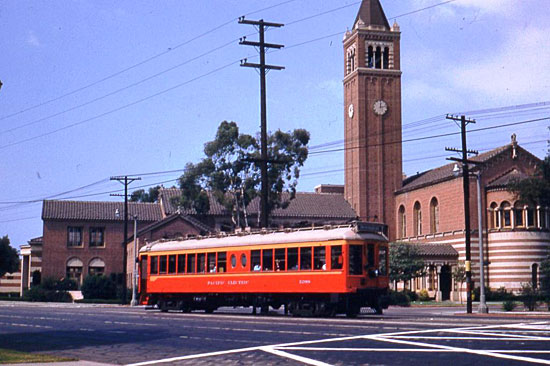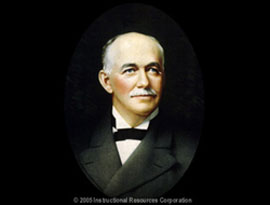This is how we rolled
November 17, 2011
Remember the Santa Monica Air Line? How about the Los Angeles & Independence?
Probably not.
But the two historic railways will be there—and not just in spirit—when the Expo Light Rail Line begins rolling from Downtown westward in just a few months, with its first terminus at La Cienega Boulevard.
Although the Westside’s first mass rail project in 50 years feels in some ways like the dawn of an era, Los Angeles has been down this road before. In fact, it has been down the same set of train tracks: The Expo Line will run on a historic railroad right-of-way that has carried Southern Californians, off and on, for more than 135 years now, first behind steam engines and then in iconic Red Cars.
“We’re definitely going back to the future,” jokes John Smatlak, a rail transit consultant and volunteer rail historian at the Orange Empire Railway Museum in Perris. “Of course, it looked a lot different back then than it does today.”
“This was a route that started out in 1875 as a steam railroad built by a silver baron,” confirms Matthew Barrett, research librarian for the Metropolitan Transportation Authority, “and then later became part of the Pacific Electric Red Car line.”
Indeed, Barrett says, some images of the Air Line from the Metro archive are being embedded as station tiles along the Expo Line as reminder of the connection. (See gallery below.)
Constructed by John P. Jones, a U.S. senator who had made a fortune in Nevada, the Expo Line route was originally the Los Angeles & Independence Railroad, the linchpin of a grand plan. Jones owned a silver mine in Inyo County and coastal ranch land where Santa Monica now stands. He wanted to connect the two with Los Angeles and persuade the city to situate its port near his slice of the shoreline.
However, his powerful rival, Southern Pacific Railroad, wanted the port to be near its lines in San Pedro, and Jones had lost bargaining power; his silver mine was exhausted. “Jones built the link from Downtown to Santa Monica, and then he went bankrupt,” says Barrett, the Metro research librarian.
In 1877, Southern Pacific bought Jones’ struggling railroad and turned it into a local freight and passenger hauler. Its cars would steam from an ornate Victorian depot Downtown to a long wharf built out into the ocean, carrying tourists and cargo through the then-sparsely populated fields and plains that would become L.A.’s Westside.
Eventually, Southern Pacific leased the line to a subsidiary run by Henry E. Huntington, the real estate tycoon nephew of the president of the railroad. Huntington electrified it and added it to the rail system he was building to less developed land holdings outside L.A.’s city limits.
Painted a bright, marketable red, Huntington’s electric cars ran between Downtown L.A. and increasingly far-flung suburbs, including Santa Monica. By 1908, the old Los Angeles & Independence rails were bustling with the so-called Red Cars and the line, which also carried a lot of freight, had been renamed “The Air Line,” a common term back then for the shortest distance between two points. In 1911, when a number of railroads merged in Southern California, it officially became part of the Pacific Electric railway.
At the peak of their popularity in the Roaring Twenties, the Red Cars covered some 1,100 miles of railway from the San Gabriel Mountains to San Bernardino to the beaches of Orange County. They became an essential part of Los Angeles’ culture and lore.
The Red Cars showed up in movies. They were written into waltzes. The depots became famous in their own right. Whole communities sprang up as so-called “streetcar suburbs.”
In his history of growth in Los Angeles, “The Reluctant Metropolis”, William Fulton wrote that Huntington “built a $60 million fortune around the Pacific Electric in little more than a decade.” But, he added, Huntington saw the Red Cars mostly as a tool for real estate speculation and disregarded the fact that, with so many lines going through L.A., “it would often take a PE [Pacific Electric] Red Car longer to leave the downtown area than to make the entire run to Pasadena or Santa Monica.”
Still, says Barrett, the Red Cars mapped the urban footprint of Southern California more than any other early influence, including the automobile. “Many assume that the freeways created our sprawl,” he says, “but it was the railways built many years earlier that laid the foundation for it.”
Eventually, Barrett and other historians say, a combination of factors caused highways and cars to displace the Red Cars. And no, they say, it wasn’t just the kind of auto and tire industry maneuvering dramatized in “Who Framed Roger Rabbit?” (“That was the Yellow Cars, not the Red Cars,” says Barrett. “That movie has done more to create incorrect local history than anything I can think of.”)
Angelenos were also the earliest auto adapters outside Detroit. Voters distrusted the railroads. Real estate speculators realized they didn’t necessarily need to invest along rail lines. By the late 1930s, the Automobile Club of Southern California was calling for “a network of traffic routes for the exclusive use of motor vehicles”—i.e., freeways—while rail advocates were struggling to build a consensus. When gas rationing during World War II ratcheted up demand for rail, it revived profits but underscored the need for investment in rail infrastructure.
“People always omit the context of the time,” says Smatlak of the Orange Empire Railway Museum—a resting place for most of what’s left of Southern California’s stock of retired Red Cars. “Yes, there were tire and rubber and gas and oil companies involved in shifting transit to buses. But by the 1950s, the rail system was really worn out and they were faced with making a massive capital investment.”
Adds Barrett: “If we have anyone to blame, it’s ourselves—or our grandparents—for not being on the steps of City Hall, demanding our electric railway system be preserved in 1943 after the first smog alert was generated.”
The Air Line stopped carrying passengers in 1953. Eight years later, the last Red Car rumbled into retirement. And, with the exception of a decade or two, Angelenos have been waiting for relief ever since, stewing in their cars.
























 405 bridge work causes a stink
405 bridge work causes a stink

